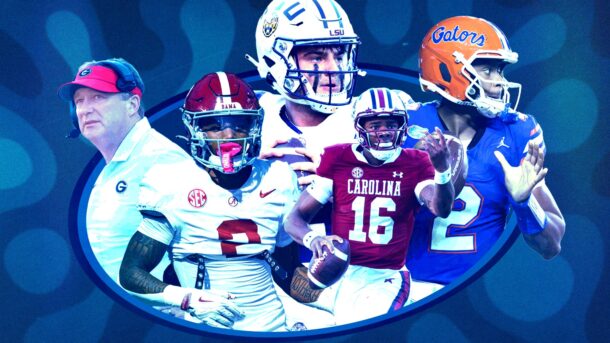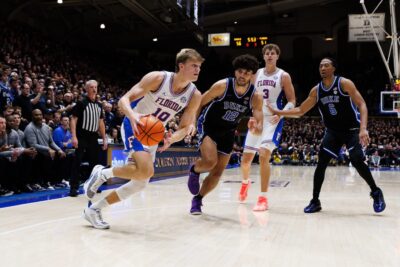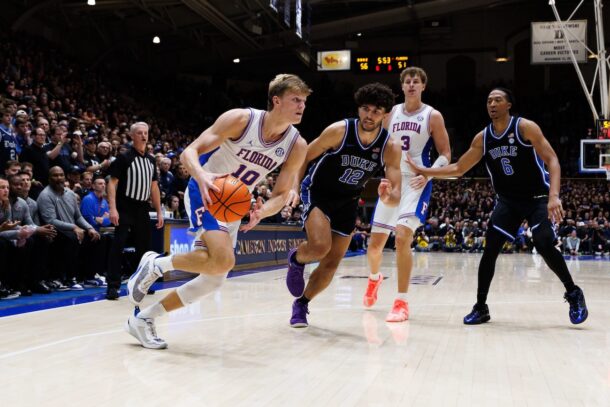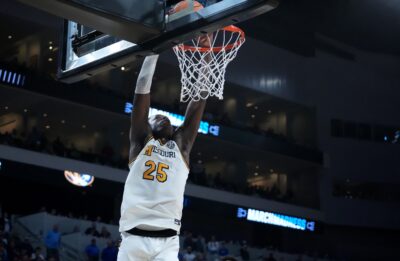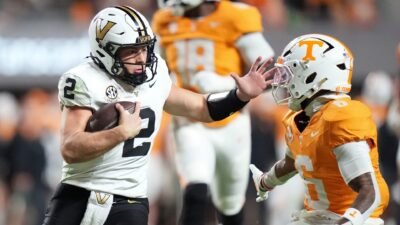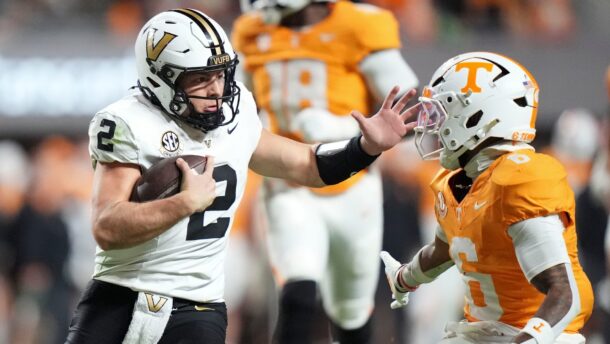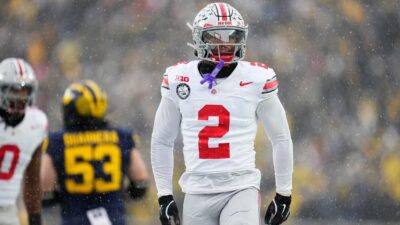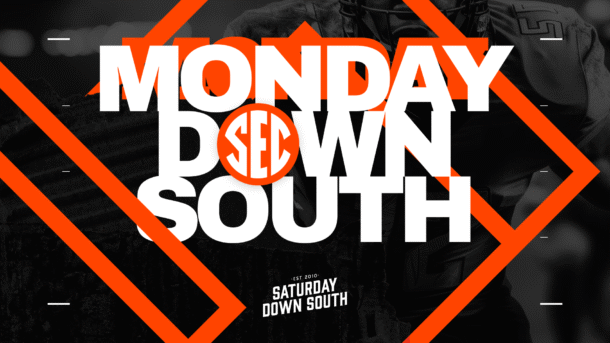
Monday Down South: Billy Napier is the latest Florida coach to exit early. Will the Gators ever get it right?
By Matt Hinton
Published:
Takeaways, trends and technicalities from Week 8 in the SEC.
The bell tolls for Billy
Certain coaches linger on the hot seat so long that finally pulling plug becomes an act of mercy, and few have lingered longer than Billy Napier. Florida put the Napier era out of its misery on Sunday, firing him less than 24 hours after a tenuous, 23-21 win over Mississippi State, and a little more than a year after the first obituaries to his tenure. Not much has changed in the meantime except the particulars.
Altogether, Napier’s Gators finished 22-23 overall, 12-16 in SEC play, 4-16 vs. ranked opponents, and 2-8 vs. annual rivals Georgia, LSU and Florida State. They never spent more than 3 consecutive weeks in the polls, or moved the needle in any discernible way except as spoilers. His swan song on Saturday — again, a conference win in which Florida led for the final 3 quarters — was punctuated by chants of “FI-RE BIL-LY” and a chorus of boos as he jogged off the field for the last time.
In that sense, Napier’s run in Gainesville was arguably an even bigger flop than the decade-long succession of flops that preceded it. The previous 3 guys in the job before him, Will Muschamp (2011-14), Jim McElwain (2015-17), and Dan Mullen (2018-21), also failed to make it to the end of their 4th season before their respective administrations unraveled. But at least they all managed go out with winning records. At least there were moments in each of their tenures, however fleeting, when Florida seemed relevant. The Gators won 11 games under Muschamp in 2012; played in back-to-back SEC Championship Games under McElwain in 2015 and ’16; and spent most of Mullen’s first 3 seasons ranked in the AP top 10 before the bottom fell out in Year 4. If the 12-team Playoff had existed in those years, they would have made the cut a handful of times as an at-large. Under Napier, the project never really got off the ground, topping out with an 8-5 record last year as the result of an improbable 4-game win streak to end the year. Aside from a round of residual (and quickly deflated) preseason hype coming into this season, it never came close.
Zoom out, though, and in the long run the Napier era is merely a continuation of the extended period of frustration since the literal and figurative collapse of the Urban Meyer regime. In many ways it was all too familiar. Like McElwain, Napier arrived in December 2022 as a former Nick Saban assistant with little profile of his own, the Saban connection counting for at least as much as far as Florida was concerned as his brief but successful run as head coach at UL-Lafayette. Like Mullen, he was often dismissed as a second-rate recruiter whose developmental mindset was better suited to an off-brand underdog than to a program that expects to compete with the Bamas, LSUs and Georgias of the world for 5-star specimens. And like Muschamp, his teams were characterized by turgid offenses, combustible defenses, and stupid penalties at conspicuous moments. (Come to think of it, that was occasionally a Mullen thing, too.) The Gators had their moments on Napier’s watch; unlike his doomed predecessors, they also had a couple of potentially transformative talents at quarterback, Anthony Richardson and DJ Lagway, the crown jewel of Napier’s 3 full recruiting classes. But they never had anything resembling a coherent identity.
Therein lies the challenge for whoever comes next: What is Florida football? It’s been awhile since there was a satisfying answer to that question. For a long time, Florida perennially checked in at or near the top of the list of “Best Jobs in College Football” as a result of its resources, a championship track record under multiple coaches, and privileged geography in recruiting. In the NIL/portal era, none of those advantages really holds true anymore, and frankly hasn’t for a while.
After watching 4 consecutive administrations crash and burn over a span of 15 years, it’s past time to ask whether the malaise says as much about the job itself as it does the overwhelmed busts who have held it. For one thing, the resource gap between the sport’s Haves and Have Nots has narrowed significantly since the Gators’ most recent hey day — at least within the power conferences — and is only going to continue to shrink as a result of revenue sharing and an accompanying cap on player salaries. If anything, Florida has been notoriously slower to adapt to the realities of the arms race than the programs it considers its peers. Meanwhile, as the cycle churns on, Gainesville looks less and less like a place where an ambitious coach can win championships and more like a place where coaches go to be buried under outdated expectations. After all, just about every major program east of the Mississippi has made inroads in Florida recruiting, and no prospect with options is making his decision anymore based on which school is within the shortest driving distance. Most of the highest-rated players in Florida have been opting to leave the state for years; the Gators rarely sign more than 1 or 2 of the top 10.
Of course, that could always change with an infusion of NIL money. Based on the recruiting sites, Florida’s 2024 and ’25 classes were its best since the pandemic, with last year’s class in particular coming together only after athletic director Scott Stricklin convinced boosters to invest the money they were prepared to put toward buying out Napier’s contract toward shoring up efforts on the trail instead. But then, these days the same thing can be said for almost anywhere else, too. Suddenly, Indiana or Texas Tech can now go out and buy itself a Playoff-caliber roster, and still afford to pay a Playoff-caliber coach an insane amount of money to stick around to build the next one. So too, for that matter, can Ole Miss, where Lane Kiffin — the candidate who has loomed at the top of Florida’s wish list since speculation began over Napier’s future last year — has built a program that has proven it can compete at a high level and reload on a regular basis even following massive attrition.
Is there anything a coach like Kiffin — or Eli Driknwitz, or Rhett Lashlee, or whatever name you want to toss in the mix — can accomplish at Florida that he can’t at a place like Ole Miss, or Missouri, or SMU, where he’s already done most of the heavy lifting and enjoys some job security? As recently as a couple years ago, that would have been a no-brainer, a question not even worth asking. Everybody knew the 12 or 15 or so jobs in which it was always possible to win big, and Florida was 1 of them, regardless of how far the Gators might have fallen at any given point in time.
Today? Who knows Kiffin or Drinkwitz or any other would-be Florida target is thinking, but the landscape is considerably flatter. Horizons are expanding and ceilings are being raised across the country. In any given year now, there are likely to be a dozen teams in the SEC thinking big.
Presumably Florida is always going to do what it takes to be among them. But if it’s going to re-establish itself as a destination, rather than just another aspiring outfit whose trophy case is increasingly irrelevant to a generation of players who couldn’t even begin to tell you what the letters “BCS” stand for, it cannot afford to keep hitting reset every 3 1/2 years. The next guy needs to be in it for the long haul.
Bottom’s up
If it seems like every other game this year is a nail-biter, it’s not just in your head: Per Associated Press reporter Josh Dubow, the average margin of victory in SEC games so far this season is just 10 points, down nearly a full touchdown per game compared to conference play from 2010-23. In fact, if it holds up, Dubow reports that 10 ppg is on pace to be the narrowest margin of victory in any conference since at least the turn of the century. From top to bottom, the league is as competitive week-in, week-out as it has been in a long time.
That’s obvious enough at the top, where the days of Alabama and/or Georgia cruising through the regular season without having to so much as tap their brakes are over. Not that the Tide and Dawgs can’t still go all the way. But the path so far has been anything but smooth or inevitable — especially for Georgia, which has trailed in the second half in 3 of its 4 conference wins. Saturday’s wild, 43-35 marathon against Ole Miss featured 6 lead changes and a 17-0 4th-quarter rally by the Bulldogs to erase a 9-point deficit at the end of the 3rd. Par for the course these days. Altogether, 10 SEC teams are ranked in the updated AP poll, 8 of whom still have at least a 30% chance of making the Playoff according to ESPN’s Football Power Index. The race for those tickets over the next 6 weeks is going to be a battle of attrition.
But I would argue the case for parity across the conference is just as compelling at the bottom, if not more so. For now, anyway, regression to the mean in the portal/NIL era is working in both directions. Consider the 4 teams that have yet to win a conference game: Arkansas, Auburn, Kentucky and Mississippi State, which are a combined 0-14 in SEC play. Depressing stuff. Contrary to the standings, though, the actual gap between the bottom tier and the broad middle class on the field has been razor-thin. Nine of those 14 losses have come by a touchdown or less, including down-to-the-wire efforts by all 4 teams on Saturday.
Auburn remained snake-bitten, missing 3 field goals in a double–overtime loss against Missouri. Kentucky, which began the day as the conference’s only double-digit underdog, stuffed Texas’ entire offense into a locker only to lose a 16-13 heartbreaker in overtime. Mississippi State was within range of a game-winning field goal at Florida before serving up a gut-wrenching interception to clinch a 2-point loss in The Swamp. And Arkansas — poor, exhausted Arkansas — hung 527 yards and 42 points on undefeated Texas A&M in yet another shootout loss in Fayetteville, the Razorbacks’ 4th loss already with at least 31 points in defeat. For the year, the Hogs rank No. 2 nationally in total offense vs. FBS opponents at 507.3 yards per game, with 5 consecutive losses in said games.
That’s not to pass out moral victories when actual victory was there for the taking in every one of those games. Arkansas has already fired its coach, Auburn and Kentucky are on the verge of following suit, and Mississippi State is still gritting its teeth over a 15-game SEC losing streak spanning 2 calendar years; these are all teams absolutely going through it. It’s just to make the point that when the entire bottom quartile of the league is capable of pushing Playoff hopefuls to the brink, it’s no wonder every Saturday feels like a dog fight. If we learned anything from last year’s chaotic stretch run, it’s just how much can change in 6 weeks. Weird stuff is in the air. Actually, as thin as the margins are right now, it might be more surprising if things don’t get a little weird. Put it this way: Among the would-be SEC title contenders, is there an outfit you really trust to not get its season randomly blown off the tracks by an underdog rallying under an interim head coach? If and when it happens, they can’t say they weren’t warned.
This week in Arch: U-G-L-Y
Another week, another inscrutable performance from Arch Manning, who cannot even get out of a routine road trip to Kentucky without alerting the Bust Police to his presence. Coming off his most reassuring outing of the year against Oklahoma, Manning regressed to struggle mode in Lexington, completing just 12-of-27 passes for 4.9 yards per attempt on a rock-bottom night for the Texas offense as a whole. The Longhorns finished with their fewest yards (179) and first downs (8) in more than a decade, and only reached the end zone as a result of a punt return that set up the offense at the Wildcats’ 5-yard line. (Another big return into UK territory set up a go-ahead field goal on Texas’ final possession of regulation.) Manning turned in season-lows for passer rating (85.5) and Total QBR (25.0) in what was very nearly a season-derailing disaster.
As always, it is not all about Arch. His offensive line remains a safety hazard, particularly true freshman guard Nick Brooks, who continues to look like … well, like a true freshman thrust unexpectedly into the starting lineup in SEC play. Pro Football Focus charged Brooks with 6 pressures allowed against Kentucky, including all 3 of the Wildcats’ sacks. That brings him up to an alarming 19 pressures allowed in the past 3 games. But let’s spare the rookie the brunt for the entire unit. PFF also cited center Connor Robertson, a career backup filling in due to injury, with 5 pressures, and regular tackles Brandon Baker and Trevor Goosby with 3 apiece — red flags across the board. (The only Texas lineman who wasn’t charged with a pressure on Saturday was senior DJ Campbell, who remains a pillar at right guard while the rest of the front threatens to collapse around him.) Manning never established a rhythm under constant duress, and the inability (or unwillingness) to establish the ground game didn’t help.
But whatever plays were there to be made, Manning was rarely making them. He was 8-for-16 for 70 yards on clean drop-backs, including a heavy diet of screens that fell behind the line of scrimmage; he was just 6-for-16 throwing beyond the line, where he didn’t bother to challenge Kentucky downfield and continued to routinely miss open receivers. And with a number like 6-for-16, there’s no need to cherry-pick to get the point across: Accuracy is plainly a recurring issue.
In his previous road trips, losses at Ohio State and Florida, Manning managed to offset some of his erratic tendencies and salvage some respectability on the stat sheet by connecting on a handful of downfield shots in both games. There wasn’t so much as a glimpse of that aspect of his game on Saturday night, for whatever reason. The defense was holding up its end up of the bargain, his protection wasn’t, and (by the way) Kentucky succeeded in its effort to shorten the game by racking up a nearly 2-to-1 advantage in time of possession in regulation. Texas ran just 55 offensive plays, including setting up the game-winning field goal in overtime after the defense stuffed Kentucky on 3 straight plays from the 1-yard line on the Wildcats’ turn with the ball. By that point, though, ‘Horns fans had seen enough to know they got away with one in a game they were favored to win comfortably, and that if the situation doesn’t improve ASAP it might be the last.
Stone-Cold Gunner
On the opposite end of the spectrum, Gunner Stockton could not have done much more to raise his stock in Georgia’s high-octane win over Ole Miss. The tit-for-tat pace left him with little margin for error, and he didn’t need it, finishing a near-flawless 26/31 passing for 289 yards, 4 touchdowns, and season-highs for passer rating (204.8), Total QBR (96.9) and overall PFF grade (91.0) in a reputation-making performance. His Heisman odds shortened, too. On 5 different occasions, Ole Miss scored to take or extend the lead; on all 5 occasions, the Bulldogs responded with a scoring drive of their own, managing to stay close on the Rebels’ heels through 3 quarters before pulling away decisively in the 4th.
Previously I’ve compared Stockton to a slightly bigger version of Stetson Bennett IV (complimentary), but that might be selling his skill set short. Pressed into a situation in which the offense was literally forced to score every time it touched the ball, he was up to the moment. Stockton was sharp downfield, connecting on 8-of-10 attempts of 10+ air yards; made a difference as a runner, weaving his way to a 22-yard touchdown run in the 2nd quarter; and never put the ball at risk on an afternoon when a turnover in either direction almost certainly would have spelled doom for the team that committed it. His last incomplete pass came just before halftime; in the second half, he finished 12-for-12 while leading 4 consecutive scoring drives to ice the game.
None of that would have possible without the surrounding cast, which also turned in its best game of the season. The o-line, fully intact for the first time this season, kept Stockton clean on all but 7 of his 35 drop-backs, per PFF, and didn’t allow a hit or sack. The receivers, collectively known as a butterfinger-y group, hauled in 4-of-5 contested catch attempts without a drop. Running backs Nate Frazier and Chauncey Bowens piled up 133 yards on 4.9 per carry. The tight ends finally got involved; Zachariah Branch did Dillon Bell things after the catch. When all the pieces come together, the Bulldogs still have the makings of a championship attack. And Stockton is emerging as the most important piece, by far.
The question is just how often the defense is going to continue to leave the offense with zero margin for error in a shootout. Georgia has trailed by 2 scores now at some point in 4 of its 5 SEC wins this season, an ongoing trend that started last year, which is a hard way to make a living no matter how many times you manage to pull it off. The Dawgs successfully rallied in the second half against Tennessee, Auburn and Ole Miss, getting just enough defense to take the Vols to overtime in Knoxville and to make the Rebels doubt whether they’d actually have a chance after a lopsided 4th quarter. On the other hand, they didn’t have quite enough juice to pull off the comeback against Alabama despite shutting the Tide out after halftime. Nobody should expect a revival of a vintage UGA defense circa 2022, which the current D is not by a long shot. If it can just give the offense a little breathing room, that would be worth a sigh of relief.
Dude of the Week: Alabama Edge Yhonzae Pierre
The Tide brought Pierre along slowly at first coming off a nagging preseason injury, but it didn’t take him long to play his way onto breakout watch over the first half of the season, and Bama’s 37-20 win over Tennessee was the moment the Tide have been waiting for. Pierre was borderline unblockable against the Vols: His 6 QB pressures yielded 2 sacks, as well as the most physically dominant rep of the evening — a bull rush that relocated the opposing right tackle directly into the lap of QB Joey Aguilar, forcing Aguilar to commit a panicked intentional grounding penalty in his own end zone.
The offense scored on the ensuing possession to extend the lead to 16-7 and never looked back.
Pierre has a long way to go before he’s mentioned in the same breath as some of the Bama edge rushers, but he’s off to a good start since breaking into the starting lineup following the Tide’s open date in Week 4. In 4 games since, he has generated 16 pressures and 2 forced fumbles (both against Missouri) in the past 3 games. A former 5-star, the shy is the limit.
Dud of the Week: Auburn’s Kicking Game
Auburn’s overtime loss to Missouri was littered with missed opportunities, from dropped passes to turnovers. But for a team that was counting on veteran kicker Alex McPherson to solve its field-goal woes, McPherson’s 3 misses against Mizzou — 2 from inside of 40 yards, the 3rd falling well short from 50 yards out in overtime — were especially deflating. McPherson is still working his way back to 100% from the intestinal issue that caused him to miss nearly all of last season, when the Tigers finished a dreadful 11-for-20 on field-goal attempts in his absence.
Notebook
1.) If you’re a coach on the hot seat, beating Mississippi State is the last straw. Billy Napier is the 3rd head coach in the past 5 years to get the axe immediately following a win over the Bulldogs, following Gus Malzahn and Jimbo Fisher.
2.) Alabama fans got their wish when the the Tide opened the game against Tennessee with 5-star freshman Michael Carroll in the starting lineup at right tackle. He didn’t last long: After allowing a couple of pressures, he was yanked for the guy he replaced, Wilkin Formby, who ultimately played 39 snaps to Carroll’s 25. Bama is still giving significant reps to backups at both guard spots, as well.
3.) Alabama’s game-changing pick-6at the end of the first half was play-calling malpractice by Tennessee. The Vols had the ball at Bama’s 1-yard line with no timeouts and 9 seconds left in the half — an obvious passing situation, given that an incomplete pass that left time for one more snap would be vastly preferable to a failed run that ended the half. Call your best 2-point pass! Instead, the offense lined up in an old-school goal-line formation featuring 3 tight ends, a fullback and zero receivers in a bid to get Bama to overcommit to defending a power run that almost certainly was not in the cards. No dice: Neither the personnel nor the ensuing play-action fake fooled a soul on the defense, and a lazy, badly underthrown pass by Aguilar was ripe for the picking by Zabien Brown.
The throw itself was worse than the call, but not by much. The look on the Tennessee coaches’ faces said it all: We just blew our best chance to get back in the game on a play that stood no chance.
4.) Arkansas’ season in a nutshell: Trailing 38-35 against Texas A&M, the Razorbacks lined up to stop a crucial 4th-and-1 attempt by the A&M offense from its own 34-yard line in the 4th quarter. Initially, it looked like they’d succeeded in penetrating the backfield and stuffing RB EJ Smith for a big loss — except that the defender in the best position to make the play, Justus Boone, apparently lost track of which Aggie had the ball and, in the confusion, attempted to wrap up one of Smith’s lead blockers instead. Smith, who’d been knocked off balance a full 4 yards behind the line to gain, managed to reset his feet and plunge ahead for the conversion. A&M went on to score (of course), extending its cushion to 45-35 en route to an eventual 45-42 win.
5.) I don’t have the bandwidth here to take on the full scope of hot-seat speculation surrounding virtually every coach who lost this weekend, but if Shane Beamer wasn’t thinking seriously about the possibility of filling the vacancy at his alma mater, Virginia Tech, maybe he should be. He’s fond of calling South Carolina his “dream job,” but after Saturday’s 26-7 flop against Oklahoma the Gamecocks are 1-4 in SEC play with no light at the end of the tunnel. Beamer is not generally considered a candidate for the chopping block in 2025. At the rate it’s going, though, that assumption changes with every loss; either way, he’ll certainly be feeling the heat if he returns in ’26. A reset in Blacksburg might be the best-case scenario for all parties. Just a thought.
Moment of Zen of the Week
Matt Hinton, author of 'Monday Down South' and our resident QB guru, has previously written for Dr. Saturday, CBS and Grantland.
